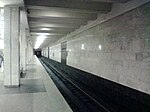Metalist Oblast Sports Complex
1926 establishments in UkraineBuildings and structures in KharkivFC Metalist KharkivFootball venues in Kharkiv OblastSlobidskyi District ... and 5 more
Sport in KharkivSports venues built in the Soviet UnionSports venues completed in 1926Sports venues in Kharkiv OblastUEFA Euro 2012 stadiums in Ukraine

"Metalist" Oblast Sports Complex (Ukrainian: Обласний спортивний комплекс "Металіст"), which includes the Metalist Stadium (Ukrainian: Стадіон "Металіст"), is a multi-use stadium in Kharkiv, Ukraine. It is used chiefly for football matches and is the home stadium of FC Metalist 1925 Kharkiv. The stadium, which was a venue for Euro 2012, currently seats 40,003 spectators. After FC Metalist Kharkiv financially collapsed in May 2016 professional football temporary disappeared from the stadium. In August 2016 Metalist 1925 Kharkiv made the stadium its home stadium. Shakhtar Donetsk followed suit in February 2017.
Excerpt from the Wikipedia article Metalist Oblast Sports Complex (License: CC BY-SA 3.0, Authors, Images).Metalist Oblast Sports Complex
Vlasovsky Lane, Kharkiv Балашовка
Geographical coordinates (GPS) Address External links Nearby Places Show on map
Geographical coordinates (GPS)
| Latitude | Longitude |
|---|---|
| N 49.980858333333 ° | E 36.261702777778 ° |
Address
Стадіон "Металіст"
Vlasovsky Lane
61001 Kharkiv, Балашовка
Kharkiv Oblast, Ukraine
Open on Google Maps









